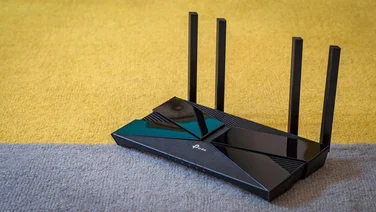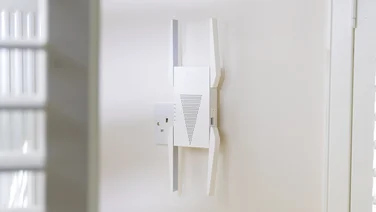To help us provide you with free impartial advice, we may earn a commission if you buy through links on our site. Learn more








- Compact and tasteful
- Easy to set up and configure
- Access-point option
- Disappointing performance
- No Wi-Fi band-splitting
The original tri-band Linksys Velop was one of the first consumer mesh networking systems on the market. When we reviewed it in 2017 we found it did a great job of extending wireless coverage throughout the home but the price was hard to swallow: even now a three-node pack will set you back a stiff £375.
READ NEXT: BT Whole Home Wi-Fi review
Linksys Velop Dual-Band review: What you need to know
Before I go any further, though, let’s get the basics out of the way first. The Linksys Velop Dual-Band is a Wi-Fi mesh networking system that works in a similar way to Google Wifi and BT’s Whole Home Wi-Fi.
It comes in the form of three separate “nodes” (you can also buy a twin pack), is designed to replace or supplement your existing wireless router and spread a strong wireless signal around your house. It does this by bouncing the signal from node to node, thus ensuring a strong signal wherever you might be.
You can use it to extend any existing wireless network, although it’s worth noting from the outset that the Linksys Velop Dual-Band does not have a built-in ADSL modem. This means that you may still need to use your ISP-supplied router or replace it with a third-party modem.
Linksys Velop Dual-Band review: Price and competition
The Velop Dual-Band is competitively priced at £220 for a three-node mesh system. There are a few even cheaper options, though: the Tenda Nova MW6 is a mere £155 while the excellent BT Whole Home Wi-Fi system comes in at £200 – although that’s an extender system that works with your existing router, rather than replacing it.
Another option is the £200 TP-Link Deco M5; in our tests, this wasn’t as fast as the BT system but it benefits from built-in antivirus and category-based web filtering.
Linksys Velop Dual-Band review: Setting up
The Velop Dual-Band is deployed in exactly the same way as the original Velop, using the Linksys smartphone app. The setup wizard guides you through each step of the process, and it’s convenient to be able to carry the phone around the house with you as you configure each node. The setup process is painfully slow, though – installing each unit involves a lot of waiting around while connections are tested and established, and the whole rigmarole took us more than half an hour. Still, you should only have to go through it once.








By default, the Velop system replaces your existing router, so once the nodes are in place you may also want to spend some time configuring your home network. This can also be done through the app, or you can use the (rather sluggish) web portal. It’s not the world’s most feature-packed router, but you can reserve IP addresses for specific devices, set up port forwarding for local services, blacklist specific websites and enforce scheduling for individual devices.
It doesn’t have an ADSL modem built in, however, so you might need to keep using your existing router. In this case, you can also set up the Velop nodes as wireless access points (this may be necessary if your ISP router cannot be put in). You might also choose to do this if you have a lot of wired clients, as each Velop unit only has two Gigabit Ethernet ports (and on the primary node one of these is taken up by the connection to your modem or router).
Once you’ve got things set up you can pretty much forget about the Velop: the three nodes appear as a single network, with the firmware automatically steering clients onto the strongest available connection from wherever they happen to be.








Linksys Velop Dual-Band: Performance
We weren’t expecting the fun-sized Velop Dual-Band nodes to be as fast as the full-sized system. The smaller nodes imply shrunken aerials and a weaker signal and that’s borne out by the fact that Linksys recommends this package for homes up to 4,500 square feet, while the original system can cover up to 6,000 square feet. What’s more, while the Velop Dual-Band uses the same 867Mbits/sec 5GHz radios as the older model, there’s only one per node instead of two. That means both client and backhaul traffic have to share the same channel, squeezing the available bandwidth.
To find out how much difference this makes in practice, I put the Velop Dual-Band through my usual set of domestic tests. First, I situated the nodes throughout my home, locating one in the living room next to my modem, the second in the kitchen in the middle of the house, and the third in the utility room at the rear of the building. Then, I tested how long it took to download a local set of 40 one-megabyte files in the living room, the upstairs bedroom and the bathroom beyond that.








Things started pretty positively: in the living room, the Velop Dual-Band model gave me a perfectly respectable 13MB/sec – slower than the 17MB/sec I’d got from the regular Velop, but still enough bandwidth to get the full benefit of a 100Mbits/sec internet connection.
Once I started roaming about the house, however, speeds fell precipitously. In the bedroom, I got just 7MB/sec, versus the original Velop’s 17MB/sec. And in the bathroom – always a tricky spot to reach, owing to a thick wall and a radio-baffling radiator – I got download speeds of just 5MB/sec, compared to 11MB/sec for the larger units.
The reason became apparent once I delved into the technical details: the 5GHz signal from the Dual-Band nodes had proved too weak to project consistently through the walls in my home – a problem I hadn’t had with the larger units – and my test laptop had automatically fallen back to the slower 2.4GHz band. This provides better penetration but, as we saw, slower speeds. And if you’re tempted to try to force a 5GHz connection, you’re out of luck, as the firmware doesn’t support band splitting.
Linksys Velop Dual-Band: Verdict
The Linksys Velop Dual-Band is easy to use and reasonably priced. If you simply want to extend a stable wireless connection around a medium-sized property, it provides everything you need in a nicely unobtrusive package. However, it’s too lightweight to deliver top performance, even at medium range. For a faster network, check out the BT Whole Home Wi-Fi kit, which is just as fast as the original Velop, yet even cheaper than the Dual-Band system.







